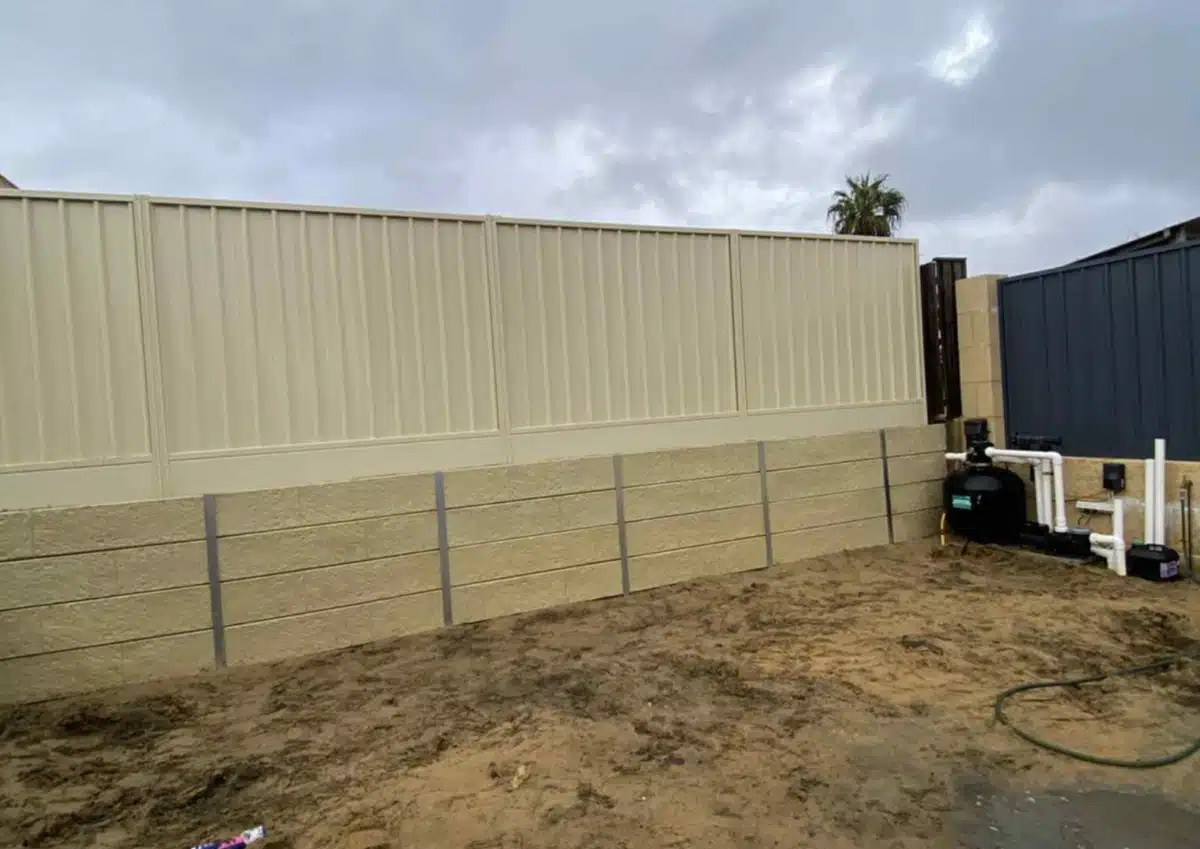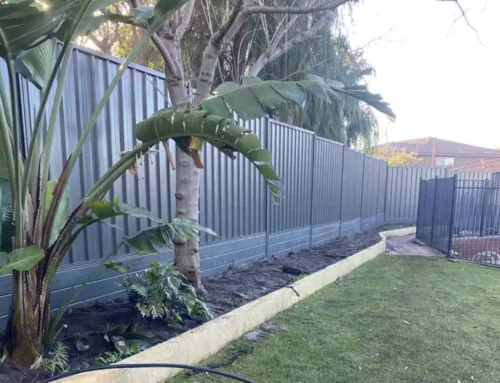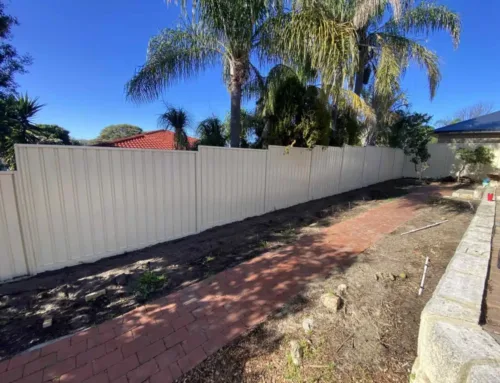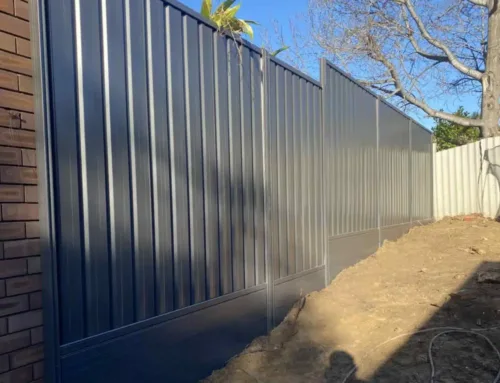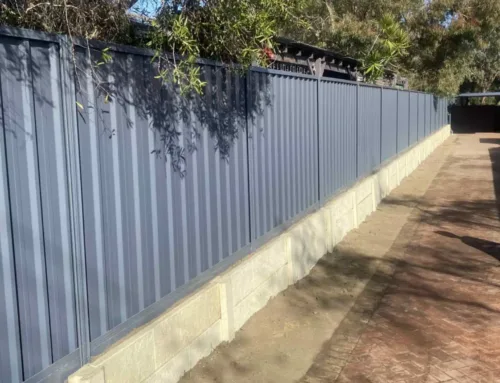admin
Choosing a fence is easier when you focus on purpose, material and local rules. This complete guide walks you through privacy, security, style, maintenance and lifespan so you can make an informed choice for your Perth home and outdoor space.
What are the different types of fences?
Most Perth homes use timber, vinyl (uPVC), aluminium, steel, composite or chain link, and each material balances privacy, security, upkeep, lifespan and cost differently.
If you want boundary fencing that blocks prying eyes, solid panels such as steel or composite create a visual barrier while keeping clean lines. Timber fencing offers traditional charm and warm texture for garden fencing and front fences, but it needs periodic re paint or oil to stay neat. Vinyl (uPVC) suits owners who prioritise low maintenance, though colours and profiles are less varied. Aluminium slat fencing gives you horizontal slats or vertical battens with adjustable gaps, so you can tune airflow and privacy screens to your preference. Steel fences appear in two main forms in Perth. Colorbond steel uses solid infill sheets for privacy, while tubular steel uses vertical bars that enhance security. Composite boards combine recycled materials with fibre-reinforced cores for a stable, colourfast surface. Chain link and wire fence systems are highly durable and budget friendly where privacy is not the main concern, such as side returns behind a solid wall or pet enclosures.
If privacy is your main concern, look first at Colorbond Fencing as a low maintenance option that also aligns easily with modern homes.
Which fence type is best for privacy vs security vs aesthetics?
Solid panels win for privacy, climb resistant bars win for security, and matching material and fence style to your facade wins for street appeal.
For privacy, choose near zero gaps. Colorbond panels, composite boards and tightly spaced slat fencing shield living areas from neighbours and help many homeowners feel at ease in pool areas and patios. For enhancing security, tubular aluminium or steel with spear tops, closer post centres and lockable hardware reduces toeholds and improves a property’s security without looking harsh. For pure visual appeal, link your fence designs to your home’s architectural style. Clean vertical slats or shadowline steel pair with contemporary homes, while picket fencing and capped palings complement traditional homes.
If you like adjustable privacy with a modern look, explore Aluminium Slat Fencing and set the gap to suit the view.
How tall should a residential fence be?
Front boundaries typically sit at 1.2 to 1.5 m for safe sight lines, side and rear runs are commonly 1.8 m for privacy, and pool fencing must be at least 1.2 m with compliant gaps and latches.
Heights vary by local council regulations, so always confirm what applies at your address. Corner lots and driveways have stricter visibility rules. On sloping sites, stepped panels help maintain legal height along the boundary without awkward transitions. For pools, the 1.2 m minimum is only the start. You need compliant latch heights, non-climbable zones, and clearances from climb points like window frames or brick columns to keep children and pets safe.
For the specific compliance details and options, see Pool Fencing.
What is the most durable fence material for my climate?
In coastal suburbs pick powder coated aluminium or Colorbond with marine grade fixings, in bush or rural areas choose steel posts with metal or composite infills, and in high rainfall zones avoid materials that swell or rot.
Sea spray accelerates corrosion on unprotected metals, which is why aluminium and Colorbond with stainless fasteners are popular around Perth’s coast. Bush or rural locations suit non-combustible materials like steel and composite that resist embers, termites and livestock pressure. In shaded, damp gardens, composite and Colorbond avoid the movement issues you see with untreated wood.
If you’re weighing steel’s weather performance, skim Colorbond Fencing Benefits for Perth-specific advantages.
Which fences are low maintenance?
Colorbond and powder coated aluminium need a periodic wash, composite boards resist fade without painting, and chain link is durable where privacy is not required.
If you want the lowest ongoing maintenance, avoid porous surfaces and complex profiles that trap dust. Metal fencing with smooth finishes rinses easily. Composite boards hold colour and shape without annual coats. Timber offers beauty but needs planned upkeep, especially when facing strong sun or retic overspray.
To compare upkeep with the most common natural option, see Timber Fencing for care tips and service life.
Pros and cons of wood vs vinyl vs aluminium
Timber is warm and fully customisable, vinyl (uPVC) is clean and low care, and aluminium is light, corrosion resistant and pool friendly.
Timber gives you the most design flexibility, from square-edge palings to feature battens and mixed materials like timber with brick columns. It suits architectural elements on character homes and pairs well with plants in the garden. Plan for ongoing maintenance to protect value. Vinyl offers colourfast panels that suit modern homes where you prefer a clean look, but impact cracks are harder to fix invisibly. Aluminium excels where salt, irrigation or pool water would make paintwork a chore, and where pool compliance demands non-rusting hardware.
If you want gates that match your chosen material and fence style, bookmark Residential Gates With Your New Fence for driveway gates and pedestrian entries.
What fence styles match modern, traditional, or farmhouse homes?
Modern homes suit vertical slats, shadowline steel and minimalist composites, traditional homes suit timber pickets or decorative tubular, and farmhouse or coastal styles suit horizontal slats or post and rail with mesh.
A modern façade benefits from simple geometry and a consistent colour scheme. A traditional cottage reads best with pickets or capped palings that echo original proportions. Farmhouse designs lean into honest materials, often mixing timber rails with a wire fence for paddock-adjacent boundaries. Use the same palette as your window frames or gutters to tie elements together and create visual appeal that resonates with potential buyers.
Browse real projects to refine your taste in the Gallery.
Are there HOA rules or city codes I need to follow for fences?
Yes, you should confirm maximum heights, permitted materials and colour controls before ordering, as well as pool and corner-lot visibility rules.
Estate covenants may specify approved fence styles, colours and heights. Heritage overlays can require specific profiles at front boundaries. If your existing fence sits inside the boundary, a survey avoids disputes when you install a new fence. Keep written neighbour consent when sharing costs or changing height.
What is the difference between privacy, semi-privacy and picket fences?
Privacy fences use solid panels to block views, semi privacy fences use slats or louvres with controlled spacing to filter views, and picket fences are decorative with clear sight lines.
Choose the level that suits each boundary. For pool area screens, semi privacy eases wind load while maintaining a garden outlook. For bedrooms and living zones, a solid wall effect keeps outdoor space usable all year. On the street, pickets and low tubular keep the façade open while setting a tidy edge.
Planning a colour palette for solid panels is easier with Colorbond Fencing Colours.
Do I need permits or property surveys before installing a fence?
You should get a boundary survey for accuracy, apply for permits where height or location exceeds local rules, and record neighbour consent for dividing fences.
Checking easements and setbacks prevents later issues with councils and utilities. Strata schemes often require committee approval. If you are near a corner, visibility splays may change your design. A short planning phase saves money and keeps good neighbours on side.
To scope your project and budget, start with the Fencing Quote Calculator.
How do fences affect property value and curb appeal?
A fence that matches your home’s architecture lifts street appeal, while solid side and rear runs increase privacy and perceived liveability.
Buyers notice consistent colours and tidy tops. Quality gates and hardware make every daily interaction feel smoother and project peace of mind. If sections are leaning or panels are loose, a small repair now protects value and avoids bigger issues later.
If you have an existing fence that needs attention, book Fencing Repairs before listing or renovating.
Is a fence necessary for pets or pool safety compliance?
Yes, pets need the right gap sizes, bottom clearances and latch heights to prevent escapes, and pools require compliant heights, latch rules and non-climb zones to meet WA law.
For dogs, reduce gaps near the ground and consider a solid kickboard where digging is likely. For cats, avoid horizontal rails that make climbing easy, and consider angled toppers. For pools, keep furniture and planter boxes outside the non-climb zone and specify self-closing, self-latching gates.
For design ideas that link compliance with style, scan Perth Pool Fencing Trends.
What is the best fence for windy areas or sloped yards?
On windy sites use stronger posts, deeper footings, closer centres and vented or slatted panels, and on slopes step panels or use raked systems designed for gradients.
Perth’s coastal breeze can strain wide solid panels. Slatted aluminium and vented steel reduce pressure without losing the look. On slopes, stepped bays keep panels level and tidy. Avoid loading a new fence onto a retaining wall unless an engineer designs it as one structure.
If your block needs both retaining and fencing, read Retaining Wall Recommendations And Material Options to choose a coordinated solution.
How long do different fence materials typically last?
With regular care, timber lasts 10 to 20 years, Colorbond steel lasts 20 to 30 years in suburban conditions, aluminium and composite last 20 to 30 years with minimal upkeep, and chain link lasts 15 to 25 years depending on coating and distance from the coast.
Service life depends on installation quality, soil conditions, irrigation and sun exposure. Good footings, correct post spacing and quality fixings often add more years than the material alone. Mixed materials such as composite infills between brick piers can combine longevity with premium street appeal.
Can a fence help with noise reduction or road visibility?
Yes, tall solid panels with no gaps reduce traffic noise best, while front fences should preserve driveway sight lines and meet local rules for safe visibility.
Noise reduction improves with mass and height, so solid materials close to the road edge help. Planting dense hedges along the road side of a solid panel creates a second layer that disperses sound. Where old asbestos sheets still form part of a boundary, replacing them improves safety and street presentation in one project.
If legacy materials are present, schedule Asbestos Fence Removal before you tackle style or colour changes.
Conclusion
Choosing a fence is about purpose first, then materials and style. Think about how you live in your garden, how you want pool areas to feel, and what will complement your home’s architecture. A good fence protects pets, secures the property, screens outdoor space from the street and aligns with local council regulations. When you pick a design that suits your climate and maintainability, you get a fence that looks good for longer and gives real peace of mind.


